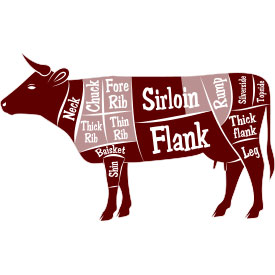
Lean cuts of beef are a good source of protein and essential nutrients. The key is to go lean and pay attention to portion sizes. According to the USDA MyPlate guidelines for daily protein intake, most adults should eat about 5-6 ½ ounces of protein each day. The serving size of protein for an adult should average about 3.5 ounces, or the size of a fist.
A lean cut of beef has plenty of flavor, which can be enhanced with herbs, spices, or a marinade. When dining out, ask the server for a recommendation on the leanest beef on the menu. A sirloin steak is often available and it is an affordable lean choice. For fast food dining, choose a single burger or cheeseburger with lettuce, tomato and a small amount of mustard or ketchup. Avoid double or a triple meat burgers and mayonnaise and bacon as toppings.
The bottom like with beef is to keep it lean, eat small portions. Select fruit or vegetable toppings for beef and burgers instead of higher fat foods.
At the Market:

Look at the nutrition label when selecting beef. The “grade” of meat has more to do with the quality of the meat than the nutrition content and is not regulated by the USDA. Meat graded “Prime” usually has more fat or marbling than “Choice” or “Select” grades. The more visible fat you see, the higher the fat and cholesterol content. Though it may be a bit more expensive grass fed beef is lower in saturated fat and cholesterol, and higher in omega-3 fatty acids.
For a 3.5-ounce serving of beef, the USDA defines a “lean” cut as containing less than 10 grams of total fat, 4.5 grams of saturated fat and 95 milligrams of cholesterol. And an “extra-lean” cut contains less than 5 grams of total fat, 2 grams of saturated fat and 95 milligrams of cholesterol.
The leanest cuts of beef include:
- Eye of round roast or steak
- Sirloin tip side steak
- Top round roast and steak
- Bottom round roast and steak
- Top sirloin steak, also called strip steak, club steak, or New York strip.
Ground meat is a popular and affordable option as a protein choice, ground sirloin or ground round with a 90% lean or higher label are the healthiest choices. A good point to remember is if the name of the cut contains the words “round” or “loin”, it is leaner than other varieties.
Storage:
Raw ground beef can be stored in the refrigerator for 1-2 days. Raw steaks and roast can be stored in the refrigerator up to 5 days. Store cooked meat in the refrigerator for up to 4 days.
Ground meat that is properly packaged in an airtight container can be safely stored in the freezer for up 4 months. Steaks and roasts can be safely stored up to one year if properly packaged.
Preparation:
Always trim visible fat from meats before cooking. To keep the meat moist and tender for grilling or broiling, marinate it in a mixture containing vinegar, wine or citrus juice for a minimum of six hours or overnight. The acids will break down the structure of the meat and make it more tender. Marinating meats adds plenty great flavor. If you do not have time to marinate the meat, prepare a rub with herbs and spices and rub it into the meat before cooking it. Overcooking beef will make it chewy and tough. Choose medium rare or medium temperatures of 145 – 160 degrees, especially when grilling or broiling.
Trade in butter, heavy cheese, bacon, and cream sauces for vegetables prepared in olive oil or raw vegetables, such a salsa, as topping choices. A little homemade barbeque sauce is also a healthy option as a burger or steak topping.
Recipe Ideas:


